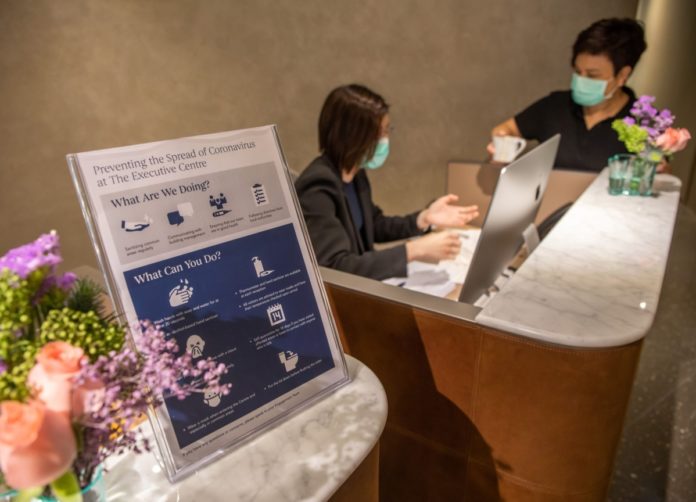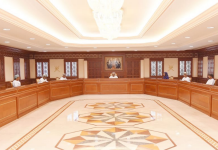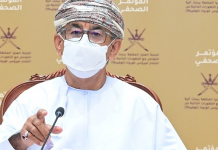(Bloomberg) — Wearable social-distancing buzzers. Masked blackjack dealers. Drive-thru electronics purchases. From cubicles to factory floors, cafes to clothing boutiques, businesses around the world are dreaming up creative ways to reopen, attempting to start revenue flowing again while minimizing the risk to customers and employees.
The global economy is riding on their ability to pull off that delicate balance. A new flareup of Covid-19 cases could shutter offices, stores, restaurants and manufacturing plants once again, further choking off the flow of goods and services and threatening more jobs. Some governments, such as China, are providing rigorous oversight of the process. Others, including President Donald Trump’s administration, have offered looser guidance and are entrusting businesses to monitor their facilities. Scientists are still studying how the virus is spread, and whether keeping people six feet apart is enough, adding to the risks.
The companies’ plans rely on a steady supply of masks, gloves, thermometers and tests that is likely to strain budgets and manufacturers’ ability to keep up. Social distancing will be built in, with people divided by barriers and kept apart from colleagues and customers, a U-turn after years of movement toward open floor plans. Some companies will monitor employees more closely than ever before, while others will let workers choose how much protection they need. The way we work, shop, travel and eat in 2020 – and probably beyond – is being plotted out in boardrooms around the world.
Here are the changes companies are contemplating for their workplaces in the coming weeks.
The Office
Seats on the shuttle bus to Unilever’s Shanghai offices can be reserved using a chat group. Employees must be masked to board, and they sit on alternating sides, one person to each four-seat row. Upon arrival, each worker scans a QR code and fills out a health status report to get a daily pass to enter. Then comes the temperature check and the hand sanitizer.
Inside the office, movement is tightly regulated. Employees keep their masks on and are encouraged to use the stairs instead of the elevator, with spritzes of hand sanitizer before and after touching the regularly disinfected handrail. In the canteen, a single person is allowed at each four-seat table.
Such measures might seem predictable in a centrally controlled society like China, but some version of them is starting to appear in the West. At Britain’s former state phone monopoly, BT Group Plc, call center workers sit two meters apart, and walkways are designated as one-way to keep people from brushing past each other. Temperature checks are becoming routine at Sistema, the Russian conglomerate, which also says it’s developed its own two-hour test for Covid-19. Employees who come to the office have been tested in the past couple of weeks, though as many as half of the call center workers at MTS, the mobile network controlled by Sistema, are operating out of their homes.
More Room
Flexible space operator Knotel, which runs offices for corporations including Uber and Netflix, says workplace design has to change. Offices will likely be less densely populated, and altered to make them “antiviral,” according to Amol Sarva, Knotel’s chief executive officer.
“Things like ventilation, UV light, density screening, video monitoring, and temperature monitoring, cleaning protocols — those are all going to have to change,” he said. “Certainly there’ll be more space.”
In China, Cushman & Wakefield has helped move nearly a million workers back into 800 million square feet (74 million square meters) of office space. The company is creating a Recovery Readiness manual for landlords and tenants, based in part on its experience in China, that includes colored carpets to create visual boundaries around desks, plexiglass shields between desks that face each other and signs that direct walking traffic in a single direction.
Fewer Meetings
Even when people do come back to the office, meetings will be limited, and large gatherings are out of the question. This week, Facebook Inc. CEO Mark Zuckerberg canceled all physical events of 50 or more people through June 2021. The vast majority of employees are required to work from home through May, and those who need to carry on doing so will be able to work at home through the summer.
The road to normalcy may be much longer than that. At Abcam Plc, a British protein research company, 40 out of 300 China-based employees started returning to work in Beijing, Shanghai, Hangzhou and Hong Kong on Feb. 14. Two months later, the company is running split shifts to maintain distancing for the roughly 50% of employees based in manufacturing, logistics and essential lab work.
The Factory
On Feb. 10, Winly Automotive (Wuhan) Ltd. was assigned a checklist from the government. To reopen, the company would be required to have a one-month stash of masks and sanitizer, take a photo of the supplies, and send it to officials before submitting to a detailed inspection. “The policy has been constantly changing,” said Wang Xuepan, one of the plant’s managers. “It’s very difficult for us to handle.”
In the Seattle area, Boeing Co. has worked with the Washington state labor department on a plan to reopen its factories. It will be doling out cloth masks to most workers, saving the gold-standard N95 masks for a select few in more hazardous conditions.
Unlike office drones, factory workers have to show up in person to get the job done. Figuring out what basic protections they’ll need is part of the challenge. At Boeing, industrial engineers are analyzing the sequence of work on its assembly lines to find ways to spread apart workers.
Taking the Temperature
Airbus SE has divided employees at its plants into red and blue teams, who don’t see each other because they use different routes to enter and exit buildings. Volkswagen AG is allotting more time between shifts and reducing expectations for production because it takes longer for people to move around each other at a safe distance. Ford Motor Co. is experimenting with wearable devices that would buzz workers if they get too close together.
While the virus can be transmitted by people with no symptoms, many manufacturers are doing temperature checks, whether with thermometers, thermal imaging cameras or — in the case of Fiat Chrysler Automobiles NV in the U.S. — reusable forehead strips.
Fiat Chrysler, whose CEO Mike Manley is one of the executives talking with Trump about reopening the economy, is requiring workers to fill out a health questionnaire two hours before reporting to work each day. They must bring either a hard copy, or scan a QR code with their phone, to prove they aren’t displaying signs of illness or exposure to the virus, according to documents obtained by Bloomberg. Workers can’t enter the plant without it.
Some companies are closing cafeterias in favor of vending machines. Dongfeng PSA in Wuhan is handing out prepared lunchboxes to employees, who must eat at least 1.5 meters apart with their backs to each other.
Zhejiang Geely Holding Group Co. said Chairman Li Shufu wrote a song to keep workers motivated through such dreariness. “A world full of expectations/Turned to dust of yesterday,” the lyrics go. “Their sorrow flowing into the sea/But the flower of love is quietly blooming.”
The Airplane
When air travel resumes in earnest, it’s likely that hand sanitizers, face masks and thermometers will become standard at most major airports, said David Powell, medical adviser for the International Air Transport Association, a trade group. All three have shortcomings, but can also reassure passengers, he said.
The International Civil Aviation Organization, which sets global flying standards, wants to establish a “public health corridor concept.” Under such a plan, major airlines, airports, public authorities and other parties would adopt common protocols for screening, boarding, in-flight procedures, arrivals, customs and baggage.
“We cannot all just stop flying,” Ansa Jordaan, the group’s chief of aviation medicine, said during an April 15 webcast.
Emirates Airline said this week it was the first to conduct rapid Covid-19 blood tests, with results available in 10 minutes for passengers flying Wednesday from Dubai to Tunisia. It plans to extend the procedure to other flights, according to Chief Operating Officer Adel Al Redha.
Other carriers are attempting less invasive measures. Etihad Airways, another major airline in the United Arab Emirates, plans to deploy touchless self-service devices at its hub airport in Abu Dhabi to identify travelers with medical conditions, including the early stages of coronavirus.
In the U.S., American Airlines Group Inc. plans to continue spacing customers apart during boarding and flights, conducting extensive cleanings of aircraft and reducing food and beverage service to limit contact, CEO Doug Parker said in an April 15 video message.
“When you do fly, aircraft cleanliness and social distancing matter greatly,” he said.
The Store
In China, it’s become standard to have your temperature taken any time you want to go shopping. Visitors to the Wuhan International Plaza luxury mall are checked for a fever at the door, before they queue up to be served one at a time at Louis Vuitton.
Levi Strauss & Co. disinfects its Chinese stores three times a day and requires temperature checks for customers, who are expected to wear masks before entering the store. Fitting rooms and products that have been tried on are disinfected each time they’re used.
It’s unclear whether practices implemented in China will make their way to other parts of the world, though several companies said they’ll learn from their experience in Asia.
Drive-Thru Shopping
Another technique is to keep shoppers out of the store altogether. Dixons Carphone Plc, the electronics retailer, is considering plans for contact-free “drive-thru” style stores to limit the risk of coronavirus for staff and customers. Shoppers would park outside, call the store to select items to buy, use a contactless system to pay and then open their trunks so staff could deliver the products.
Salespeople at luxury retailers in China were already using social media to engage with customers before the outbreak, but they’ve stepped up the effort since, adding clients on WeChat and sending them information about the latest trends. Louis Vuitton tried showcasing its summer product line in a livestream show on March 26 featuring a social-media star, but was ridiculed for the quality of the video. Sometimes there’s no substitute for personal contact.
The Restaurant
Buffets and salad bars will be re-thought, and self-serve drink stations may be “a thing of the past,” said Taco John’s CEO Jim Creel, who added that other changes are afoot at the 387-store chain. Taco John’s popular salsa bar — around for the past 15 years — may be removed.
“We hope we don’t have to take them out — that we’ll be able to figure out a way to make them still work — but I’m afraid the fear factor our there will force us to go to a pre-packaged option.”
A test of self-ordering kiosks may also get pulled back. “It was a good idea three months ago, but not so good today,” Creel said.
Phone Pay
In China, restaurants and even bars have opened back up in Shanghai, with varying limits on seating arrangements – some allow six to a table, others only one. In Beijing, restaurants are doing temperature checks. In Wuhan, most places are still delivery-only.
“In the short run, as dining rooms open back up again, you’ll probably see many restaurants space their tables a little bit further apart,” said Jack Li, CEO of menu researcher Datassential. “You’ll see more restaurants try to adopt phone pay. So not having to hand your money or card to anyone. You’re certainly going to see more places continue to do things like contactless delivery.”
Starbucks Corp. is taking a store-by-store approach to resuming business activities in the U.S., with services limited to drive-thru, delivery and takeout via mobile orders and contactless pickup.
“As we experienced in China, this will be a journey,” CEO Kevin Johnson wrote in a memo to staff on Thursday.
The Menu
Chains are cutting back menus, focusing on products that sell best and are easy to make. Romano’s Macaroni Grill has pared down its menu to 70% of what it used to be, saying goodbye to pizzas and calzones recently. McDonald’s all-day breakfast menu is gone.
Fazoli’s Italian restaurant chain is trying to secure Purell sanitizing stations – four for each store — along with “millions” of alcohol-based wipes for re-opening the dining rooms of its 216 locations. The company is also re-thinking bathrooms and looking into touch-less soap dispensers. It’s an investment, but a worthwhile one, says CEO Carl Howard.
“I want to let the consumer know I’m doing everything I can to keep them as safe as possible,” Howard said in an interview.
The Arena
Large public gatherings aren’t top of mind yet in China, but Trump and the people who run the U.S.’s biggest sports leagues appear aligned in their thinking that live games, at least in some form, are a critical part of helping the country recover.
“The progression needs to be open outdoor sports first, golf, tennis, swimming so that we can start to test the waters — that I’m fine with,” said billionaire Mark Cuban, who owns the NBA’s Dallas Mavericks.
One obstacle may be local politicians. When UFC floated plans to host an event this weekend on tribal land in California without spectators, it was pressure from politicians, including Governor Gavin Newsom, that led to its cancellation. Los Angeles Mayor Eric Garcetti has reportedly discussed the possibility of prohibiting large gatherings like concerts and sporting events in the city for another year.
The Movies
That said, there’s billions on the line for sports leagues, sponsors and media networks if the games don’t resume soon. Anthony Fauci, the nation’s leading infectious-disease expert, has said that that the only way to do that this summer is to close venues to fans and keep all the players, coaches and referees isolated from society.
Cinema owners are also waiting to see when health officials give them clearance to open up. Cinemark Holdings Inc., the third-largest U.S. movie chain, has been in discussions with major film studios about when to release blockbusters again. The chain’s management thinks they could begin bringing back staff starting in late June, then build up a marketing campaign for a broader re-opening on July 1.
The experience won’t be like it was before coronavirus hit. The chain will either have to limit the available tickets for each showing, leaving about half its seats open. Or it may eliminate reserved seating, so customers can voluntarily spread themselves out when they arrive. Cleaning will have to be ramped up, and opening hours may be limited to accommodate the changes.
“How long that will take? We’re not completely certain,” said Mark Zoradi, Cinemark’s CEO, on a call with analysts and investors on Wednesday. “But we’re planning on anywhere from one to three months to light up that engine again and then to begin with higher profile, new product.”
The Casino
Las Vegas casino executives have discussed opening with as little as one-third of their rooms available, with limited entrances where guests’ temperatures could be checked. Casino employees would wear masks and gloves, and gamblers would sit at least a chair apart at blackjack tables.
The moves are similar to what is already occurring in Macau, the world’s largest gambling market, where casinos closed for 15 days in February and reopened under tight restrictions.
The companies are also discussing enhanced cleaning techniques, something unions have requested.
Fun Parks
The $19.3 billion U.S. theme park industry is also making plans, though no one knows when gates will reopen.
When they do, employees may be wearing masks and temperatures may be checked not only at the entrances but inside as well, said Dennis Speigel, a theme park consultant in Cincinnati. Operators may also institute virtual queues, where guests snag a place in line through an app and come to ride when it’s their turn.
“The theme park of the future is going to have to take a much different turn, from distancing to wanding to cleaning,” Speigel said. “I’ve never heard the fear in the voices that I’ve heard. Nobody knows what they’re going to be doing.”






